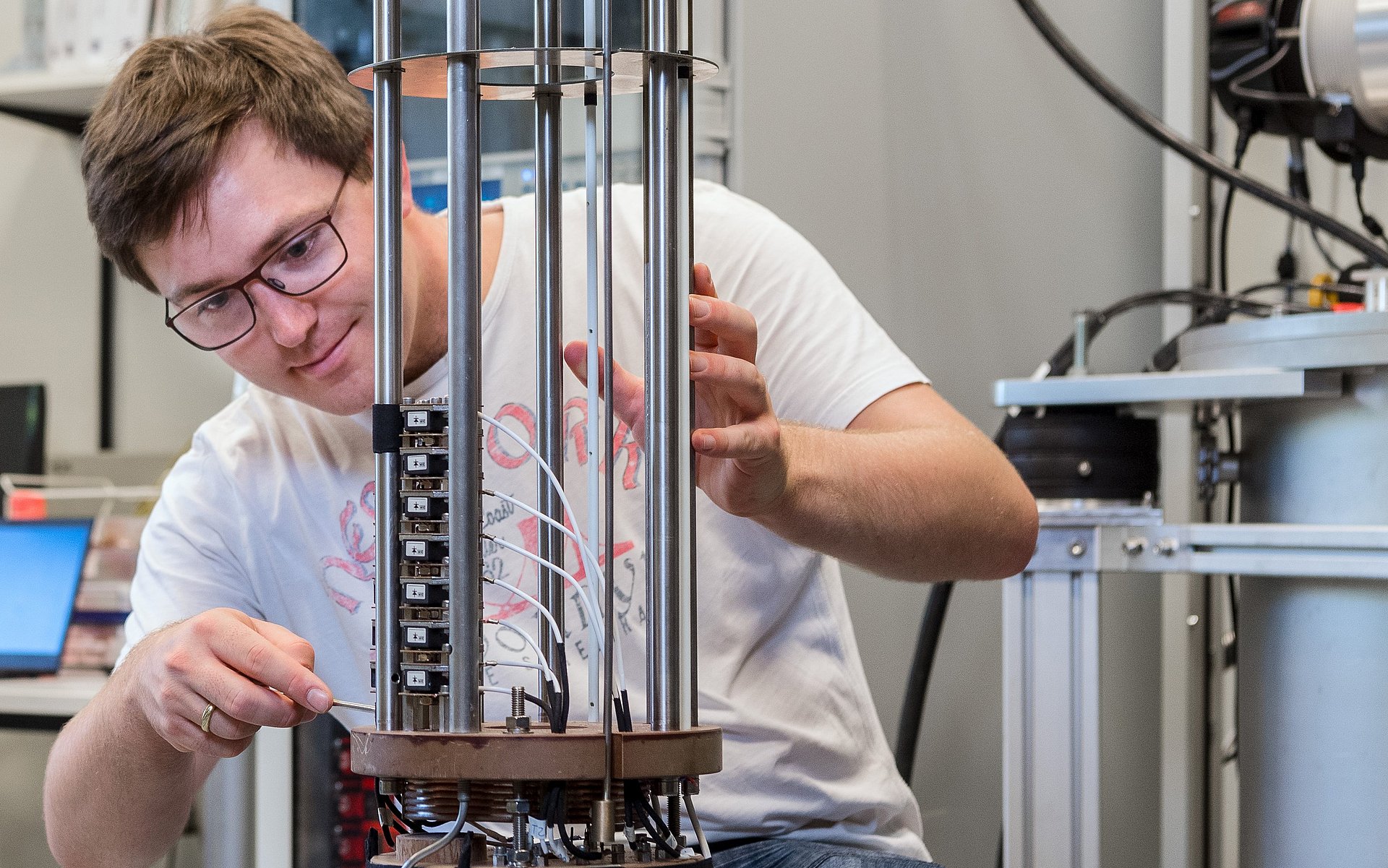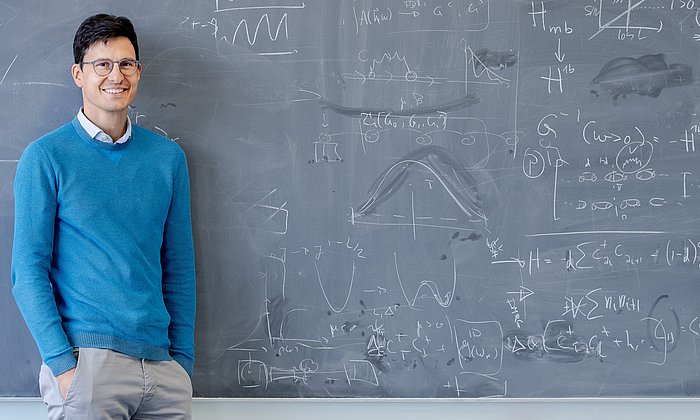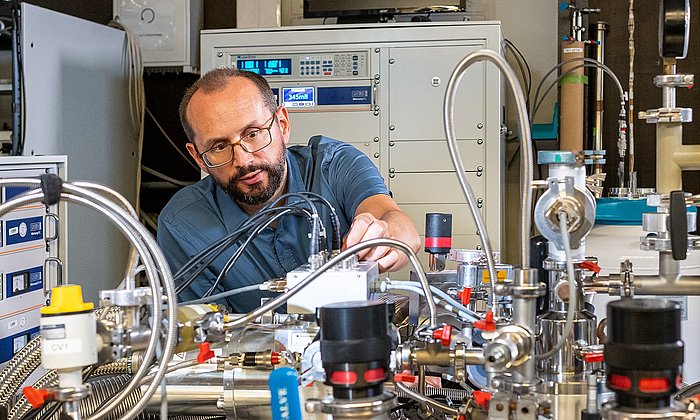New insights into quantum phenomena at phase transitions
Quantum matter: entanglement of many atoms detected for the first time

To observe phase transitions in familiar temperature ranges, we can look at water. At 100°C it evaporates into a gas and at 0°C it freezes into ice. In all three states, the atoms display different forms of order that change abruptly across well-defined transitions. Such ordered states are also referred to as phases, separated accordingly by phase transitions. Material properties such as magnetism, superconductivity or ferroelectricity are also ordered phases, however, of the electrons in solids.
Near absolute zero, at -273.15°C, the behavior of materials can no longer be explained by classical theories. Here quantum mechanics plays a crucial role, in particular the phenomenon of entanglement, in which particles share a quantum mechanical state. If a phase transition occurs at absolute zero, for example by means of a magnetic force, the entanglement changes and specialists speak of a quantum phase transition. As for high temperatures, quantum phase transitions result in an abrupt change of the material properties.
New type of phase transition discovered
“Despite more than 30 years of extensive research dedicated to phase transitions in quantum materials, we previously assumed that the phenomenon of entanglement plays an important role at tiny distance and time scales only,” explains Matthias Vojta, Chair of Theoretical Solid State Physics at TUD. In their investigation of lithium holmium fluoride (LiHoF4), the team was able to demonstrate under which conditions quantum entanglement can be studied on much larger scales. “We discovered a new type of quantum transition in which magnetic domains play a decisive role.”
Spherical samples permit precise measurements
LiHoF4 is a ferromagnet at very low temperatures. However, if a strong magnetic field is applied exactly perpendicular to the preferred magnetic direction, the ferromagnetism vanishes entirely above a quantum phase transition. This phenomenon has been known for a long time. In their studies, the researchers now changed the direction of the magnetic field. Andreas Wendl, who conducted the experiments as part of his doctoral thesis work, explains: “We used spherical samples for our precision measurements. This allowed us to investigate the behavior in response to a small tilt of the magnetic field.”
In doing so, the researchers made a surprising observation. “We discovered that the quantum phase transition continues to exist, whereas it was previously believed that even the smallest tilt of the magnetic field would immediately suppress the transition,” says Christian Pfleiderer, professor of Experimental Physics for the Topology of Correlated Systems at TUM. Instead of the expected gradual variation in the material’s properties, the team observed an abrupt change – the defining feature of a phase transition.
The cause of these transitions according to the researchers is what is known as textures. These refer to the rough patterns in which the particles organize themselves in their microscopically ordered states. In ice these are mutually tilted crystallites and in magnets these are magnetic domains, also known as Weiss domains. Until now it was unclear whether textures can exhibit quantum phase transitions by themselves. The researchers have now discovered that this is possible and thus demonstrated that quantum entanglement also takes place at the level of textures – in other words for large numbers of atoms.
Significance for quantum technologies
On the basis of their data, the researchers have developed a new theoretical model. “For our analysis, we had to generalize existing microscopic models to take into account the tilt of the magnetic field,” says Heike Eisenlohr, who performed the calculations as part of her PhD thesis. “As an entirely new aspect, we then also calculated the feedback of the ferromagnetic domains on the microscopic properties.”
The discovery of the new quantum phase transitions and the underlying theoretical model promise to be important as a foundation and general frame of reference for research on quantum phenomena in materials, as well as for new applications: “Quantum entanglement could be controlled and applied in such technologies as quantum sensors and quantum computers,” says Vojta. Pfleiderer adds: “Our work relates to fundamental research. However, it could soon have a direct impact on real-world applications with targeted use of the newly discovered material properties.”
Wendl, A., Eisenlohr, H., Rucker, F. et al.: Emergence of mesoscale quantum phase transitions in a ferromagnet. Nature 609, 65–70 (2022).
doi.org/10.1038/s41586-022-04995-5
- Picture for editorial use: https://mediatum.ub.tum.de/1688727
- The research was funded through the Excellence Initiative of the German federal government and states within the framework of the Würzburg-Dresden Cluster of Excellence – Complexity and Topology in Quantum Matter (ct.qmat; spokesman Matthias Vojta) and the Cluster of Excellence – Munich Center for Quantum Science and Technology (MCQST). Funding was also provided by the European Research Council (ERC) under the Advanced Grant ExQuiSid program and the German Research Foundation (DFG) within the framework of the Collaborative Research Centers 1143 and TRR80. Christian Pfleiderer is the Director of the Center for Quantum Engineering (ZQE) at the Technical University of Munich (TUM), currently under construction on the Garching Campus.
Technical University of Munich
Corporate Communications Center
- Stefanie Reiffert
- stefanie.reiffert@tum.de
- presse@tum.de
- Teamwebsite
Contacts to this article:
Prof. Dr. Christian Pfleiderer
Technical University of Munich (TUM)
Chair of Experimental Physics on the Topology of Correlated Systems
Center for Quantum Engineering (ZQE)
Tel: +49 89 289 14720
christian.pfleiderer@tum.de
Prof. Dr. Matthias Vojta
Technical University of Dresden
Chair of Theoretical Solid State Physics
Excellence Cluster ct.qmat – Complexity and Topology in Quantum Matter
Co-spokesman in Dresden
Tel: +49 351 463 34135
matthias.vojta@tu-dresden.de



